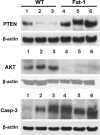Melanoma growth is reduced in fat-1 transgenic mice: impact of omega-6/omega-3 essential fatty acids
- PMID: 16888035
- PMCID: PMC1567907
- DOI: 10.1073/pnas.0605394103
Melanoma growth is reduced in fat-1 transgenic mice: impact of omega-6/omega-3 essential fatty acids
Abstract
An important nutritional question as to whether the ratio of omega-6 (n-6) to omega-3 (n-3) fatty acids plays a role in tumorigenesis remains to be clarified in well qualified experimental models. The recently engineered fat-1 mice, which can convert n-6 to n-3 fatty acids and have a balanced ratio of n-6 to n-3 fatty acids in their tissues and organs independent of diet, allow carefully controlled studies to be performed in the absence of potential confounding factors of diet and therefore are a useful model for elucidating the role of n-6/n-3 fatty acid ratio in tumorigenesis. We implanted mouse melanoma B16 cells into transgenic and WT littermates and examined the incidence of tumor formation and tumor growth rate. The results showed a dramatic reduction of melanoma formation and growth in fat-1 transgenic mice. The level of n-3 fatty acids and their metabolite prostaglandin E(3) (PGE(3)) were much higher (but the n-6/n-3 ratio is much lower) in the tumor and surrounding tissues of fat-1 mice than that of WT animals. The phosphatase and tensin homologue deleted on the chromosome 10 (PTEN) gene was significantly up-regulated in the fat-1 mice. In vitro experiments showed that addition of the n-3 fatty acid eicosapentaenoic acid or PGE(3) inhibited the growth of B16 cell line and increased the expression of PTEN, which could be partially attenuated by inhibition of PGE(3) production, suggesting that PGE(3) may act as an antitumor mediator. These data demonstrate an anticancer (antimelanoma) effect of n-3 fatty acids through, at least in part, activation of PTEN pathway mediated by PGE(3).
Conflict of interest statement
Conflict of interest statement: No conflicts declared.
Figures





References
-
- Lands W. E. Am. Rev. Respir. Dis. 1987;136:200–204. - PubMed
-
- Samuelsson B., Dahlen S. E., Lindgren J. A., Rouzer C. A., Serhan C. N. Science. 1987;237:1171–1176. - PubMed
-
- James M. J., Gibson R. A., Cleland L. G. Am. J. Clin. Nutr. 2000;71:343S–348S. - PubMed
-
- Calder P. C. Ann. Nutr. Metab. 1997;41:203–234. - PubMed
-
- Rose D. P., Connolly J. M. Nutr. Cancer. 2000;37:119–127. - PubMed
Publication types
MeSH terms
Substances
Grants and funding
LinkOut - more resources
Full Text Sources
Molecular Biology Databases
Research Materials

